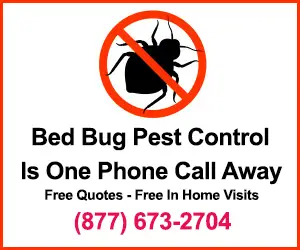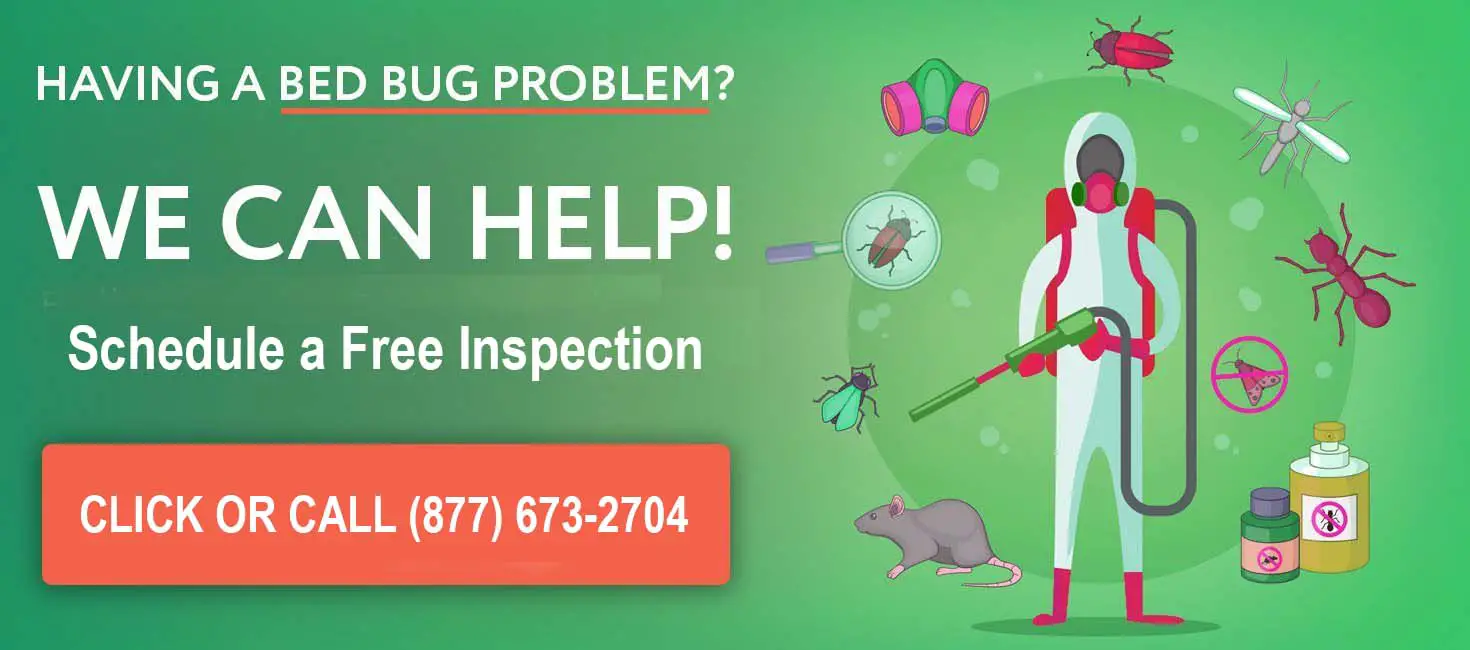Table of contents
- Finding a Licensed and Experienced Pest Control Expert
- Apartment Treatment Time
- How to Identify Bed Bugs
- Where do They Hide?
- Insects Similar in Appearance
- Preparation for Treatment
- Challenges of Treating Bed Bugs in Apartment
- Bed Bug Prevention
- What to do if You Identify Bed Bugs
- What to Expect From a Pest Control Company
- Tenant Rights
- References
"Bed bugs apartment treatment approaches can be particularly challenging, as bed bugs can spread to adjacent apartments, including those above and below the infested unit. For this reason, extermination efforts require coordination among tenants. There is a 20% chance that bed bugs will spread to adjoining apartments and a 7% chance that they will move through walls to apartments above and below the infested unit. Treatment can also be hindered by uncooperative tenants, unclear guidelines regarding who is responsible for paying the exterminator, individuals that are afraid to publicly mention they have bed bugs, and those that might refuse treatment. It is important that any prevention or treatment effort be accompanied by a building education program.. Although the name implies that they are only found in the bed, the reality is that they can reside in any room in an apartment. The key to successful bed bug extermination is extreme attention to detail. "
There are three basic approaches for getting rid of bed bugs in an apartment. These include:
- Long-term spraying: The bed bug exterminator works with those residents that actually have the bed bug problem and any apartments that are adjacent to the infested unit. Pesticides that have a residual effect are used to kill bed bugs and bed bug eggs. Most sprays contain a mix of high grade water-white kerosene combined with pyrethrum extract. The sprays must directly contact the bed bugs and bed bug eggs. Creating a mist or fog, a technique used for other insects is ineffective. Bed Bug "bombs" are also ineffective and can actually cause the bed bugs to disperse. Insect baits do not work as bed bugs feed on blood.
Sprays need to be applied to all furniture, mattresses, box spring and any other items in a room, with a focus on cracks and crevices.
Some bedbug sprays act as repellents, so they should be carefully chose. Sprays containing chlorphenapyr are effective, do not repel bed bugs and have a residual effect (Phantom Brand). Mattresses are often treated with Permethrin based products (vs. the less effective pyrethrin). Sterifab is a popular and effective choice for mattresses. - Heat: The apartment is heated to more than 120ºF to 125ºF degrees for several hours will completely kill bedbugs and their eggs. Bed bug stream treatment is also an effective way to use heat to kill bed bugs at all life stages. The heat system is provided by Temp-Air and Thermapure.
- Tenting and Fumigation: This is where the entire building is tented and fumigated. This option is expensive and the least preferred approach, but it can be highly effective when conducted for 12 hours or more. Chemicals used as fumigants include a combination of carbon dioxide, ethylene oxide, methyl formate or methylbromide. The downside of this approach is toxicity of certain chemicals to humans.
A pest control company will also vacuum all surfaces to remove any living bed bugs. Bed Bug eggs cannot be removed by vacuuming as they are attached to surfaces with a cement like substance.
An exterminator may also use bed bug dust to provide lasting protection in the home. It is a natural product that is often placed inside walls, in baseboard gaps and around electrical and cable plates. The dust attachers to bed bugs and eventually kills them. It is applied in a thin layer.
Zippered bed bug mattress and box spring covers should be used after treatment to trap any bed bugs and bed bug eggs that were missed. If a mattress is not ripped, then covers can help control a bed bug problem. Note that bed bug mattress covers will not stop bed bugs from coming from elsewhere in the room to the bed. They only help to trap any bed bugs that were already in the mattress or box spring.
After treatment, bed bug sniffing dogs are often used to determine if the problem has been eliminated. These dogs usually will inspect an apartment every 6 months. If any new outbreaks are caught, they can be treated early, which is much easier than waiting until an infestation has spread.
It always preferable for a pest control expert to apply any pesticides. If you decide to do it yourself, buy a bed bug kit which contains the needed spray and dust products. If doing it yourself it is safer to use organic or natural products first. If this doesn't work, you can try an insecticide based bed bug kit.
To learn about pesticides call the National Pesticide Information Center at 1.800.858.7378 (United States).
How to Find a Licensed and Experienced Bed Bug Pest Control Expert
While you should work with your landlord, you may be in a position where you need to consult an exterminator yourself. Treating bed bugs yourself could cost $1000 or more with some firms charging for the in-home inspection and quote. Some helpful resources that provide free quotes and other services are as follows:
- Free Bed Bug Handbook Local Bed Bug Expert Referral Service: Click Here to get our list of local bed bug experts. The entire process can be completed in under a minute. Each company will provide a free quote.
Length of Bed Bugs Apartment Treatment Time
Bed bugs apartment treatment can be as fast as 30 to 45 minutes. Larger infestations can take 3 to 4 hours to treat or longer. Request that an apartment have a reinspection 2 to 3 weeks after treatment to see if any areas were missed, if there are any late hatching bed bugs, or if an infestation spread through the walls of the apartment.
How to Identify Bed Bugs
If you live in a city that is suffering from a bed bug epidemic, homeowners should conduct frequent inspections for bed bugs. A convenient time to do this is when you remove and wash the bed sheets, as mattress markings are a key sign that there is a problem. Studies show that approximately 50% of bed bugs in a room are in the bed area.
During the day, bed bugs in a bed bugs apartment hide out of site in cracks, crevices and other thin hiding places such as the spaces between bed slats. They are often found in mattress seams, box springs, inside bed legs and on wood furniture surfaces. As time goes by, they leave behind bedbug skins from molting, feces and hatched eggs.
The bed bugs themselves change in appearance throughout their life cycle. They start in eggs that are whitish in color and oval. The eggs are about the size of a pin head. Areas in a bed bugs apartment where bed bugs hide develop a smell given off by bed bugs, which is one of the smells detected by bed bug dogs, in addition to other smells not detectable by humans.
Bed bugs come out of hiding in a bed bugs apartment at night to feed. They will feed on family members and pets. A feeding lasts for 10 minutes and is not felt by the person when it is happening due to an anesthetic produced by the bed bug. A minority of people, but not all, will have an allergic skin reaction to the bite, which is actually a single puncture from a stylet located on the bed bug head.
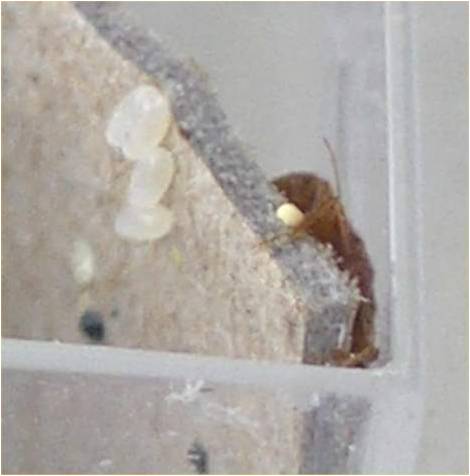 Bed Bugs Eggs (Enlarged Photo)
Bed Bugs Eggs (Enlarged Photo)Bed bugs move through 5 nymph or baby bed bug life stages starting with a small tannish transparent appearance and then growing into the more familiar brown/red. The 6th life stage is adulthood. They also change in a appearance after feeding. An instar or baby bed bug will enlarge and appear red in color because of the ingested blood. Each stage is pictured below:
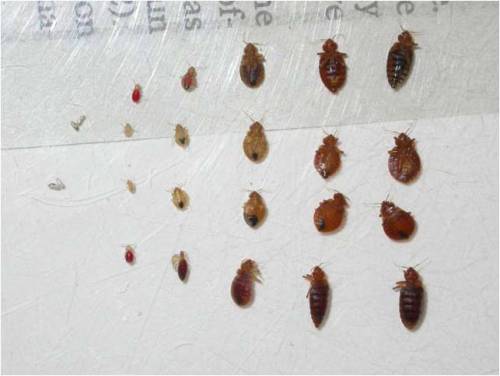 Bed Bug Life Styles
Bed Bug Life Styles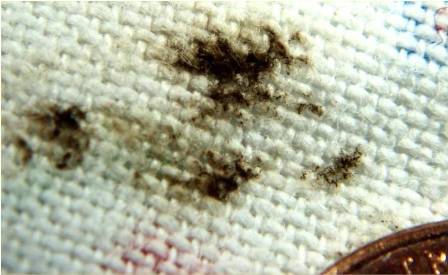 Bed Bug Mattress Stains
Bed Bug Mattress StainsFollow these step by step instructions for how to identify bed bugs apartment problems:
- Inspect the bed for markings, droppings and eggs::Remove all blankets and other bedding. Check the box spring and check the mattress. Be sure to remove or peel back the fabric that covers the bottom of the box spring. Inspect inside. Look for blood stains, feces and other marks.
- Check along the mattress seams and particularly under the label. Bed bugs are flat and can hide in small thin spaces the width of a credit card.
- Inspect the bed frame, bed frame joints and headboard. If the headboard is cracked, seal those areas. A flashlight can be helpful during the bed bug inspection process.
- Inspect the bed bugs apartment
- If you have nightstands, remove all items and look around and underneath drawers. Inspect in the area of the bed to avoid spreading any bedbugs throughout the room.
- Check an window coverings such as curtains. If the curtains are near your bed, they could contain bed bugs as this is a popular hiding area.
- Inspect any wall hangings such as mirrors, paintings, pictures, particularly on the reverse side.
- Inspect all outlets. Be careful around electrical outlets.
Where Do Bed Bugs Hide?
A pest control management study indicated that bed bugs were found in the following places by a group of exterminators:
- beds (mentioned by 85% of respondents)
- bedding (52%)
- baseboards/carpet edges (37%)
- furniture such as nightstands and dressers (26%)
- couches and chairs (25%)
- walls and ceilings (14%)
- clothing (6%)
Use this diagram when determining where do bed bugs apartment hide:
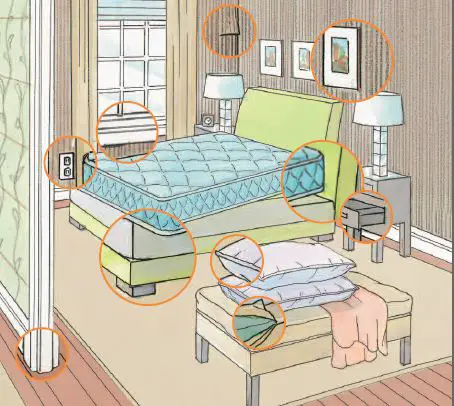 Where Do Bed Bugs Hide?
Where Do Bed Bugs Hide?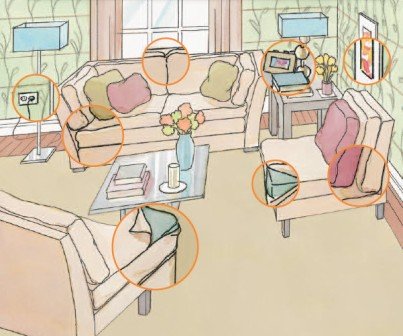 Den or Living Room: Where do bed bugs hide?
Den or Living Room: Where do bed bugs hide?
Bed bugs look like other insects, so if you are not sure, consult a pest control professional or send a sample insect with a small fee to the Harvard School of Public Health (pdf form download).
Insects that are Similar in Appearance to bed Bugs:
Bed bugs bites are also a way to determine that bed bugs are in an apartment. The majority of people will not show a bedbug bite reaction (actually a skin puncture). Any skin redness after a bed bug bite is an allergic reaction. This is why the majority of non allergic individuals show no reaction to a bed bug bite, while a spouse sleeping in the same bed can have more pronounced skin reaction.
A bed bug bite reaction can appear minutes after being bitten in a bed bugs apartment infestation or several days later. The bites will heal by themselves if not scratched and if they do not become infected. It takes 3 to 5 days for most reactions to heal. Bites are similar to those created by mosquitoes, so there is often confusion between bed bugs and other insect bites. Bed bug bites have a clear center, which is the location of the skin puncture.
Itch is usually the only symptom beside the red raised area surrounding the bite. The itch can be treated with a topical ointment from a local pharmacy or one made specifically for bed bug bites such as Emu Joy
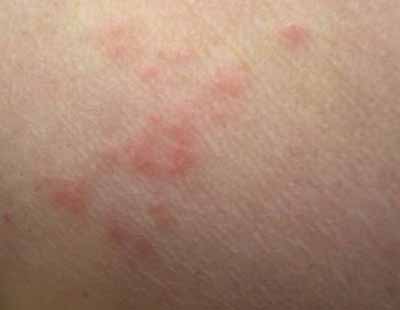 Bed Bugs Bites Reaction - immediately after being bitten
Bed Bugs Bites Reaction - immediately after being bitten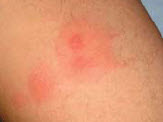 BedBug Bite on Arm
BedBug Bite on ArmHow to Prepare for a Bed Bugs Apartment Treatment
It is important to prepare each bed bugs apartment for treatment. This is particularly true for bedbug spray treatment .
- Remove any Clutter from bed bug apartment: To maximize the impact of any bed bug treatment it is helpful to maintain a clutter free home. More clutter makes it harder for any treatment to reach walls, furniture etc. Removing clutter means removing bed bug hiding places.
- Follow the Instructions from Your Pest Control Expert: They may need you to empty drawers and closets. If you do, place items in a plastic bin with a snap tight lid, or an excellent inexpensive choice is Double Zipper Ziploc Big Bags.
- Caulk and Seal cracks in the bed bugs apartment: Try and minimize the number of places where a bed bug can hide. Fill in any cracks, areas where pipes move through walls etc.
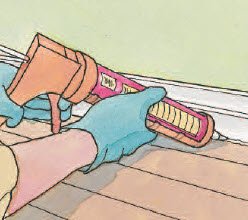 Caulk any Cracks to Remove Bed Bug Hiding Places
to Keep Bed Bugs Apartment Problems from Moving into Your Unit
Caulk any Cracks to Remove Bed Bug Hiding Places
to Keep Bed Bugs Apartment Problems from Moving into Your Unit- Wash all Clothes and Blankets: All clothes and bedding should be washed in hot water. Place into sealed plastic bags, Ziploc Big Bags (recommended) or a plastic container to avoid dropping any bed bugs. Wash on the hottest temperature and then move into the drier for 20 minutes, hot setting. You can also put shoes into the drier and stuffed animals, but only if they can withstand the drier. After items dry, place in new bags and seal for the full length of the treatment (may be 3 weeks). Keep clean clothes available for use during treatment. The goal is to minimize the items that are exposed to bed bugs and that are in the treatment area.
- Vacuum: A vacuum is an effective way to pick up live bed bugs. Use the crevice tool along mattress seams and the edges of the room. When done, remove vacuum bag in room being treated and place into plastic bag for disposal outside of the home or building.
- Move Furniture Away From Walls: It is not necessary that furniture and mattresses be thrown out. Furniture should be move away from walls about 12 inches to allow access to the walls.
Other steps for bed bugs apartment treatment include:
- Remove pets and children on day of treatment and for several hours after treatment as concluded.
- Keep fish tanks covered and pump off during treatment to avoid any pesticide entering the water.
Challenges of Treating Bed Bugs in Apartments
- Home owner cooperation is needed for any building planning bed bug treatment. Tenants or apartment owners should always:
- Inspect and ensure that all used furniture is bed bug free.
- Continually inspect mattresses for signs of bed bugs.
- Prepare an apartment before treatment to provide access to all furniture and walls. Bed bugs can even hide behind electrical outlets or inside electronics.
- Report all bed bug sitings to building management.
- Participate in bed bugs apartment tenant education programs. Make reporting bed bugs a plus vs. something that will embarrass a tenant.
Bed Bugs Apartment Prevention
The key to preventing bed bugs apartment issues is not to bring them into the apartment building in the first place. Tips include:
- Ban used furniture obtained from the street, particularly mattresses and bed frames. Used furniture and mattresses are often the way bed bugs get into a building. Rental furniture can also be a source of bed bugs. Even new furniture that is transported with new furniture can be a source of a bed bug problem.
- Reduce clutter. Clutter provides places for bed bugs to hide and makes it difficult for chemical based treatment to kill the bed bugs and the bed bug eggs.
- Only use white sheets. It is easier to notice bed bug related stains on white.
- Check your mattress every week to two. Spots on a mattress are one of the best indicators of a bed bug infestation.
- Do not visit apartments that have a bed bug problem. If you do, change clothes before entering back into your home. Place clothes in a Ziploc Double Zipper Big Bag or plastic container with a lid that snaps on. Bring clothes directly to either the washing machine and/or dryer. 20 minutes on the dryer highest heat setting will kill bed bugs and bed bug eggs. Don't ignore your shoes as well, and at minimum inspect them to make sure they are bed bug free.
- Travel is considered one of the leading sources of bed bugs in a building, meaning travelers pick them up in one destination and carry them to another. If you have a tenant committee or co-op or condo board, consider having them purchase a PackTite heater. Luggage, clothing and other items can be placed into the PackTite. It looks like a vinyl case. Heat is used to reach the temperatures required to kill bed bugs and bed bug eggs. This way you can be certain that items you bring into a home are bed bug free. You can buy a PackTite for about $250.
- Be careful when traveling. Check the mattress before bringing luggage into a room. Consider packing Ziploc Big Bags, and use them to either hold clothes inside the luggage or place the entire suitcase into the big bag for protection.
- Seal any cracks in walls to keep them from moving into your apartment from an adjacent bed bugs infested apartment. Fill cracks first with a bed bug dust product. When completing new construction, consider adding bed bug dust to the inside of the wall for an extra layer of protection.
What to do if you Identify Bed Bugs
Every building should establish a written set of procedures for addressing a bed bugs apartment problem. If you think you have bed bugs, follow these steps:
- Inspect the bed including the mattress and compare to the picture above. Inspect rooms where you or your family spends time , such as the television viewing room or den.
- If you find bed bugs, notify your landlord. Ask the landlord to schedule a pest control treatment with an extermination service. Note that the law isn't always clear as to who pays for treatment. See advice at bottom of this page.
- Have the exterminator confirm that you have a bed bug problem. Be sure to accompany the exterminator and ask for visual confirmation of the bed bug infestation.
- Prepare the apartment prior to treatment.
- Ask if more than 1 treatment is going to be provided. It is normal to require 2 treatments over 2 or 3 weeks.
- Purchase bed bug proof covers for your mattress AND box spring. These will not prevent bed bugs by themselves. They will trap bed bugs and bed bug eggs that were missed during treatment. It is not necessary to throw out a mattress or box spring that is in good condition. After all, if bed bugs are in the home, they will just spread to the new mattress.
What to Expect from a Bed Bug Pest Control Company
Any pest control expert should inform you regarding what types of chemical and non-chemical approaches used to treat bed bugs apartment problems. They should be:
- Inspecting all adjacent units in a building
- Sealing any cracks where bed bugs have been or can hide (or have your landlord do it).
- Bed bug treatment should include non-chemical methods and chemical methods. These can include a freezing sprayer, steam heat, insecticide based sprays and bed bug dust.
- Help with bed bug education including tenant education on how to get rid of bed bugs in the building.
Your Bed Bugs Apartment Tenant Rights
As of 8/31/2010, only one State Maine, and one city - New York require that landlords disclose a buildings past 12 month bed bug history to prospective tenants. These are called right-to-know laws.
Most municipal or government codes that cover tenant and landlord rights struggle to define who is responsible for treating a bed bug infestation. You'll have to do some research to determine if their is a clear ordinance in your town, city or state. A good starting point is your local public health department and the state attorney generals office.
While it is important to notify your landlord, be sure to check your bed bugs apartment related rights first. We have heard from unscrupulous landlords, particularly among people renting single family homes, that have faced eviction and blamed for bringing the bed bugs into the home.
For example, in Ontario, the Ontario Residential Tenancy Act states that the landlord is responsible for all pest control. Specifically "A landlord is responsible for providing and maintaining a residential complex, including the rental units in it, in a good state of repair and fit for habitation and for complying with health, safety, housing and maintenance standards (2006 c. 17, s.20. A landlord must hire a professionally licensed pest control company.
In Toronto, all home owners can call the Toronto Health Connection at 416.338.7600 for bed bugs apartment information. You can also contact legal clinics for advice at 416.645.8080.
In the United States, in most, but not all areas, there are laws which say something like....it is the obligation of the landlord to keep all areas under control...free from all accumulations of debris, filth, rubbish, garbage, rodents, and vermin. Most tenant laws also require landlords to maintain residences in a "habitable" condition.
The problem is that bed bugs are not always considered to be "vermin" and are not specifically regulated since they don't spread disease (although bites can lead to disease such as skin infection).
The law is quickly changing with new legislation in Cleveland now protecting tenants. Also, the Ohio State legislature is considering a bill that will protect tenants.
Many landlords will attempt to blame the tenant as having brought the bed bugs apartment problem into a building and in turn they may refuse treatment, since treatment is expensive. There first move might be to convince the tenant (s) to pay for the treatment.
Because of this, you should know your rights. This includes asking questions about bed bugs specifically and pest control before you move into a building. Check the lease you are signing to see if it indicates your rights vs. the landlords rights.
Call your Department of Housing to see if they will get involved with a bed bugs apartment problem see if they will step in to order the landlord to pay for any bed bug treatment. You can also ask a local Code Enforcement department for an inspection. You can also contact the local Department of Health, the local Attorney General's Office and the State Attorney General's office to determine your bed bugs apartment rights.
You can also check our local bed bug resources page for bed bugs apartment information on specific states and cities. A list of State by State tenants rights can be found on HUD.gov.
In some areas, it might be easier to negotiate with a landlord about a bed bugs apartment problem than to fight and allow the infestation to grow.
Be sure to register any bed bugs apartment complaints in writing to both local health offices and to the landlord. If your building management or landlord does not take action, you can consider the following steps suggested by Mike Piepsny, executive director of the Cleveland Tenants Organization:
- Organize and poll tenants to determine how many tenants are suffering from a bed bug problem.
- Create a petition demanding that the landlord treat the building. Collect as many signatures as possible. If a tenant doesn't act, send a copy of the petition to the local news media, a local county and state politician and the local department of health.
- Refuse to pay rent, and instead put it in escrow. If all tenants put their rent in escrow, a landlord will have a financial interest to do something.
- Hire a local attorney and take the landlord to court for refusing to control insects in the building. Seek a court order.
References Bed Bugs Apartment:
Preventing and Getting Rid of Bed Bugs Safely
NYC Department of Health
All About BedBugs
Woodgreen Community Services and Habitat Services
Closing in on Bed Bugs
Kramer, Richard D.
PCT
Battling Bed Bugs in the USA
Michael F. Potter, Alvaro Romero
and Kenneth F. Haynes
Department of Entomology, S-225 Agricultural Science Bldg. N,
University of Kentucky, Lexington, KY 40546-0091
What to do if your apartment comes with bedbugs: Advice for tenants and landlords
Cleveland Plain Dealer
Sheryl Harris
Ask a Question or Share Your Bed Bug Experience With Others
Do you have a question or great story about bed bugs? Share it!
